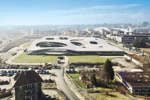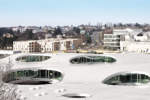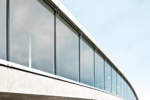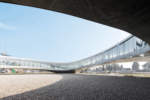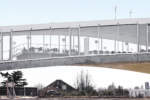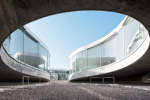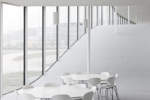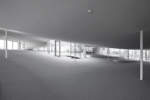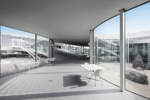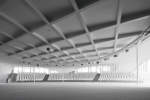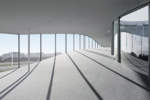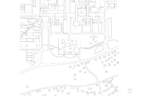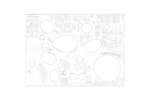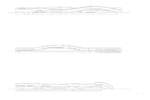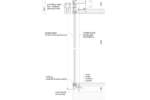architect: SANAA
location: Lausanne, Switzerland
year: 2010
Designed by the Japanese architectural practice SANAA, led by Kazuyo Sejima and Ryue Nishizawa, the Rolex Learning Center is a highly experimental building, designed for new ways of study and interaction in the 21st century. Located centrally on the EPFL campus the building is essentially one continuous structure spread over a site of 88,000 sqm; the building is rectangular in plan, but appears to be more organic in shape because of the way that its roof and floor undulate gently, always in parallel. With few visible supports, the building touches the ground lightly, leaving an expanse of open space beneath which draws people from all sides towards a central entrance. Inside, the hills, valleys and plateaus formed by the undulation often make the edges of the building invisible. Instead of steps and staircases, there are gentle slopes and terraces. Clearly, but without dividing walls, one area of activity gives way to another.
As well as providing social areas and an impressive auditorium, the building lends itself to the establishment of quiet zones and silent zones, acoustically separated areas created through changes in height. The slopes, valleys and plateaus within the building, as well as the shapes made by the patios, all contribute to these barrier-free delineations of space. In addition, clusters of glazed or walled ‘bubbles‘ make small enclosures for small groups to meet or work together in. The topography lends an extraordinary fluidity to the building‘s flexible open plan – a flow that is
emphasised by fourteen voids in the structure, of varying dimensions. These are glazed and create a series of softly rounded external ‘patios‘, as the architects describe them. The patios are social spaces and provide a visual link between the inside and the outside. They are very much part of the building. From the higher areas, visitors may enjoy views not only of the campus but, spectacularly, of Lake Geneva and the Alps. With all its unity and variety, the Rolex Learning Center is an ‘intimate public space‘. The Rolex Learning Center embodies the aims and philosophy of the EPFL, setting the scene for different kinds of collaborative, cross-disciplinary research, regarded as essential to advances in science and technology. It offers flexibility to use the building in many different ways, now and in the future, to absorb new technology and working methods, as they come on stream, many of them developed within EPFL itself. The building emphasises sociability, getting together for coffee, for lunch, for study, for seminars, to stimulate informal encounters between people of all the key disciplines. It is designed to be a landmark, a place people will want to visit, allowing EPFL to reach out to the surrounding community and internationally.
The acclaimed Japanese architectural practice SANAA (an acronym for ”Sejima and Nishizawa and Associates”) was established in 1995 by Kazuyo Sejima and Ryue Nishizawa. SANAA’s pioneering buildings have created an architecture that marries aesthetic simplicity with technical complexity. SANAA’s most recent major project is the New Museum of Contemporary Art in New York. In 2009 they designed the Serpentine Gallery Summer Pavilion in London. Other notable projects include the 21st Century Museumof Contemporary Art Kanazawa in Japan, and the Louvre-Lens in France.



